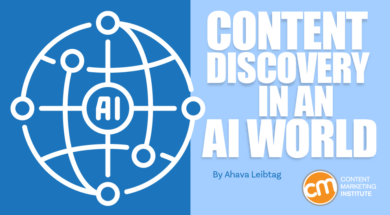 ChatGPT, Bing, and Google’s Bard grab the headlines. The evolving use of AI-generative content tools prompts fear, excitement, and chaos among marketers.
ChatGPT, Bing, and Google’s Bard grab the headlines. The evolving use of AI-generative content tools prompts fear, excitement, and chaos among marketers.
It’s clear why. You need help. Forty-six percent of marketers say one person (or group) is in charge of their organization’s content calendar. Who wouldn’t want to taste the AI apple?
More importantly, you need to get your brand’s content where your audience is. Even with its limitations, machine learning has changed how many people search. Google has long used AI to deliver the right answers so searchers don’t have to click for more information. AI content generators, like ChatGPT, also attract a share of searchers who prefer those tools for more detailed answers (that don’t require a click.)
How do you adapt to get your content discovered by your targeted audience in this AI-entrenched world? Take a pause to reflect and strategize.
How do you get your #content discovered by your targeted audience in this #AI-entrenched world, asks @ahaval via @CMIContent. Click To Tweet
AI brings limitations
Start the update for your content discovery strategy by understanding the downside of AI tools. Consider these three factors:
1. Machines can’t understand intent
Social media and search algorithms are improving at offering readers the content they want. But understanding user intent remains a work in progress and always will.
Let’s say someone searches for “jaguars.” Do they want information about the animal, the Jacksonville, Fla., football team, or the British car manufacturer? Google wouldn’t know, and it wouldn’t ask them to clarify. It would take its best guess, and the searcher would likely need to refine their search at least once.
A machine can’t know definitively what a reader wants, so people must refine their searches. That data feeds into the AI tool to improve the algorithm, but it will never be perfect.
2. Nuance is lost on AI
A machine struggles to understand nuance. It communicates complex topics in a black-and-white way. As the “father of modern linguistics,” Noam Chomsky explains:
[Machine-learning programs’] deepest flaw is the absence of the most critical capacity of any intelligence: to say not only what is the case, what was the case and what will be the case — that’s description and prediction — but also what is not the case and what could and could not be the case.
Machine-learning programs neglect to communicate with nuance. They “learn” from the online information, accurate or not, and fail to view complex situations from multiple lenses.
3. AI spreads misinformation and bias
Chatbots like ChatGPT and Bard can’t decipher what’s accurate information and what’s fake news. Bard made headlines when it got a fact wrong about the James Webb Space Telescope in its first demo. The AI tool made a mistake because it scraped and spat out misinterpreted news, extending the life cycle of false information.
Bard made the mistake of saying the telescope took the first pictures of a planet outside of this solar system in this tweet:
Bard is an experimental conversational AI service, powered by LaMDA. Built using our large language models and drawing on information from the web, it’s a launchpad for curiosity and can help simplify complex topics → https://t.co/fSp531xKy3 pic.twitter.com/JecHXVmt8l
— Google (@Google) February 6, 2023
At the same time, machine-learning programs are “trained” by people, so human bias is a real concern. For example, someone trained a computer model created to identify melanomas with clinical images. Unfortunately, 95% of the images in the training data set depicted white skin, which begs the question, “Would the computer model miss or over-diagnose skin cancers in patients of color?”
AI-created content can be wrong, biased, and misused. Therefore, it needs to be fact-checked. You can better address the challenges in your content discovery strategy by understanding them.
How to succeed in today’s search landscape
As companies like BuzzFeed and many others flood the internet with AI-created content, you can stay on higher ground by following these five steps:
1. Optimize your content for discovery
Algorithms personalize the user experience more than ever through the platform’s discovery page (i.e., TikTok’s for-you page). So make your posts “discoverable” on social media and Google Discover to help your followers and others in your target audience see your content.
One of our clients, Amanda Todorovich, executive director of content marketing at Cleveland Clinic, shares how to do that on social media, including:
- Use creative, algorithm-friendly formats (such as video).
- Catch the scroller’s attention with visuals and hooks.
- Deliver quick and actionable value to readers.
Of course, you don’t need to stop there. Encourage readers to engage with your social posts by adding calls to action and tagging the content to match their intent. To improve your chances of Google Discover featuring your content, follow its content policies and recommendations.
2. Prioritize your audience
Pull your data to answer two questions about your target audience:
- Where do they hang out online?
- How, and most importantly, where do they search for information?
Dig into your brand’s Google Analytics, social follower demographics, CRM data, and insights from your sales team. Let the data drive your strategy and determine where the leads come from. Then, focus more of your efforts on those channels.
Use your data to find out where your target audience searches for information online, says @ahaval via @CMIContent. Click To Tweet
TIP: Search is multifaceted. Yes, your audience can find your content on the page of a search engine. But they could just as easily find your content on social media channels.
3. Create with journalistic integrity
The potential for misinformation to multiply in an AI world makes readers’ trust hard to earn. Be a reliable source of information by:
- Supporting your claims with research and subject matter experts.
- Citing vetted primary sources.
- Adding the publishing date to your articles.
- Approaching complex topics through multiple lenses.
- Covering topics with appropriate depth, including counterarguments and avoiding generalizations.
4. Plan content that can be repurposed
Staying competitive (and discoverable) with chatbot-based content mills requires multiple forms of content. Repurposing is the solution.
As you create long-form content, consider subtopics that can spin into other forms. Scrape the best moments or insights and bring them to life in a new way:
- Spin podcasts into YouTube Shorts or Reels.
- Turn blog articles into newsletters.
- Transform research findings into social media posts.
5. Stay true to your brand
Stand out in the crowd of content by honing your brand’s voice. Don’t sound like a robot — your readers will notice if every sentence has three clauses. Don’t sound like your competition, either. They’re all spinning content about the same topic. Instead, write about issues that truly matter to your customers in a way that they want to consume them.
Overcome the content discovery challenge
Finally, remember that chatbots and algorithms have a long way to go before they can:
- Understand user intent.
- Communicate with nuance.
- Decipher what’s true or false.
- Check biases.
So lean into what makes your brand sparkle, and you’ll add value to the content marketplace and continue to build trust with your audience. Be consistent in how you show up online, and you’ll become recognizable in a roiling sea of sameness.
All tools mentioned in the article are identified by the author. If you have a tool to suggest, please feel free to add it in the comments.
HANDPICKED RELATED CONTENT:
Cover image by Joseph Kalinowski/Content Marketing Institute




